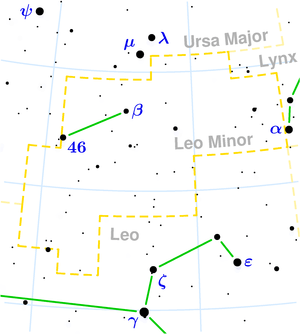|
|
Leo Minor ( Latin: smaller lion) is a rather dim constellation that can barely be recognized as a triangle and lies between the easily discerned constellations Ursa Major and Leo. In contrast to Leo it does not belong to the ancient list of 48 constellations drawn up by Ptolemy in the 2nd century AD, but was instead created by Johannes Hevelius in 1687. Notable features There is little to see for owners of small telescopes. There is only one star brighter than 4m: * 46 LMi (Praecipua): an almost (but not quite) giant star of spectral class K0 which lies at a distance of approximately 98 light years and sports an apparent brightness of 3.83m. Praecipua does not have a Bayer designation, making Leo Minor the only constellation whose brightest star does not have one. * β LMi: strangely enough this giant star of spectral class G8 is the only star with a Bayer designation, and with its apparent magnitude of 4.21m it is not even the brightest star of Leo Minor. * R LMi: the brightness of this cool long-period variable star (a Mira variable) varies between 6.3m and 13.2m during a period of 372.19 days. * 20 LMi: this binary star system is only 14.9 parsecs away from the Sun. Notable deep sky objects Leo Minor does not contain any notable deep sky objects. The brightest one is NGC 3003, a galaxy with an apparent brightness of 11.7m and an angular size of 5.9 arcminutes. It is seen almost edge-on. See also * Leo References * Ian Ridpath and Wil Tirion (2007). Stars and Planets Guide Links
Retrieved from "http://en.wikipedia.org/"
|
|
||||||||||||||||||||||||||||||||||||||||||||||||||||
